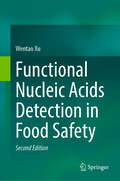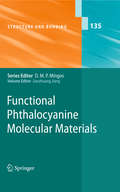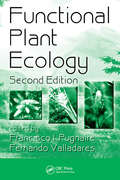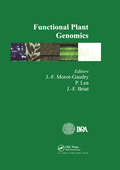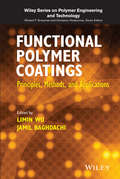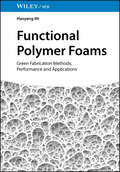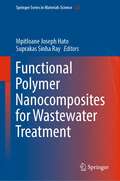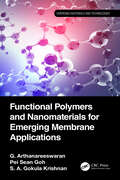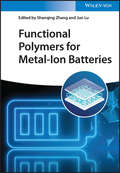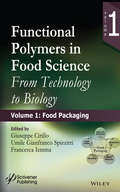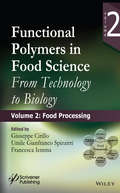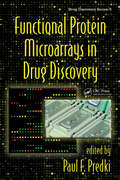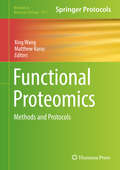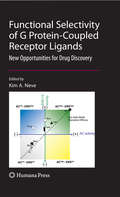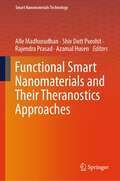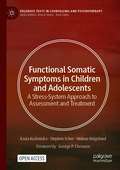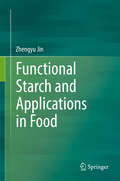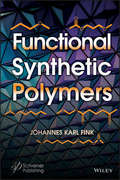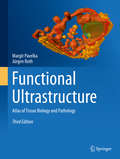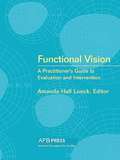- Table View
- List View
Functional Nucleic Acids Detection in Food Safety
by Wentao XuThis book focuses on the development of functional nucleic acids and their applications of molecular detection methods in the context of food safety. The book has been expanded to 24 chapters based on the first edition including five newly-added chapters, of which involving the systematic introduction of currently-fashionable functional nucleic acid elements, the basic mechanism of diverse amplification technologies, and the novel design strategies of detection methods from the latest research findings for food safety. Offering a comprehensive overview of nucleic acids detection method in food safety for professionals and members of the public interested in this area.
Functional Nucleic Acids for Analytical Applications
by Yi Lu Yingfu LiNature has long used nucleic acid aptamers and enzymes for regulatory activities, such as the recently discovered "riboswitches" involved in gene expression. The existence of a large array of natural and artificial functional nucleic acids has generated tremendous enthusiasm and new opportunities for molecular scientists from diverse disciplines to devise new concepts and real applications that take advantage of those nucleic acids for sensing and other analytical applications. This book provides a timely and comprehensive overview of recent advances in the field, from leading experts in biology, chemistry, and engineering. A variety of topics are covered, from fundamentals of functional nucleic acids, to their applications as sensors, to nanotechnologies; as well as integration of functional nucleic acids into practical analytical systems.
Functional Phthalocyanine Molecular Materials
by Jianzhuang Jiang*This series presents critical reviews of the present position and future trends in modern chemical research concerned with chemical structure and bonding *Short and concise reports, each written by the worlds renowned experts *Still valid and useful after 5 or 10 years *More information as well as the electronic version of the whole content available at: springerlink. com Content Level Professional/practitioner
Functional Plant Ecology (Books in Soils, Plants, and the Environment)
by Francisco I. Pugnaire Fernando ValladaresFollowing in the footsteps of the successful first edition, Functional Plant Ecology, Second Edition remains the most authoritative resource in this multidisciplinary field. Extensively revised and updated, this book investigates plant structure and behavior across the ecological spectrum. It features the ecology and evolution of plant crowns and a
Functional Plant Genomics
by J F Morot-GaudryThe openings offered by functional genomics reconciles organism biology and molecular biology, in order to define an integrative biology that should allow new insights about how a phenotype is built up from a genotype in interaction with its environment. This book covers a wide area of concepts and methods in genomics. This range from international
Functional Polyimide Dielectrics: Structure, Properties, and Applications
by Jun-Wei ZhaAn of-the-moment discussion of the most cutting-edge research in the field of polyimide dielectrics In Functional Polyimide Dielectrics: Structure, Properties, and Applications, distinguished researcher Dr. Jun-Wei Zha delivers an up-to-date and authoritative discussion of the latest advancements in the application of polyimide dielectrics (PIDs) in electrical and electronic equipment. Readers will find coverage of the application of PIDs in aerospace, high-temperature energy storage capacitors, corona-resistant motors, new energy power equipment, packaging, and more. The book serves as a valuable reference for improving the performance and expanding the application of existing PIDs, as well as designing and developing new PIDs. It also provides a current overview of research and frontier applications that will prove useful to students and researchers from multiple disciplines. Functional Polyimide Dielectrics also contains: A thorough introduction to the different types of polyimide dielectrics, including their synthesis, composites & blends, processing-property relationships, processing strategies and technologies, properties and applicationsComprehensive explorations of a wide range of PID applications in a variety of special applications, like energy storage, insulation, thermal conductivity, intelligence, and morePractical discussions of the environmental aspects of the technology, as well as life cycle assessment sustainable alternative possibilitiesComplete treatments of smart polyimide dielectrics Perfect for materials scientists, electronics engineers, polymer chemists, physicists, and mechanical engineers, Functional Polyimide Dielectrics: Structure, Properties, and Applications will also benefit professionals, engineers, and scientists working in the chemical industry.
Functional Polymer Coatings
by Limin Wu Jamil BaghdachiFocusing on a variety of coatings, this book provides detailed discussion on preparation, novel techniques, recent developments, and design theories to present the advantages of each function and provide the tools for better product performance and properties. * Presents advantages and benefits of properties and applications of the novel coating types * Includes chapters on specific and novel coatings, like nanocomposite, surface wettability tunable, stimuli-responsive, anti-fouling, antibacterial, self-healing, and structural coloring * Provides detailed discussion on recent developments in the field as well as current and future perspectives * Acts as a guide for polymer and materials researchers in optimizing polymer coating properties and increasing product performance
Functional Polymer Films, 2 Volume Set
by Wolfgang Knoll Rigoberto C. AdvinculaVery thin film materials have emerged as a highly interesting and useful quasi 2D-state functionality. They have given rise to numerous applications ranging from protective and smart coatings to electronics, sensors and display technology as well as serving biological, analytical and medical purposes. The tailoring of polymer film properties and functions has become a major research field. As opposed to the traditional treatise on polymer and resin-based coatings, this one-stop reference is the first to give readers a comprehensive view of the latest macromolecular and supramolecular film-based nanotechnology. Bringing together all the important facets and state-of-the-art research, the two well-structured volumes cover film assembly and depostion, functionality and patterning, and analysis and characterization. The result is an in-depth understanding of the phenomena, ordering, scale effects, fabrication, and analysis of polymer ultrathin films. This book will be a valuable addition for Materials Scientists, Polymer Chemists, Surface Scientists, Bioengineers, Coatings Specialists, Chemical Engineers, and Scientists working in this important research field and industry.
Functional Polymer Foams: Green Fabrication Methods, Performance and Applications
by Haoyang MiA one-of-a-kind exploration of the fundamentals of functional polymer foams, including their fabrication and a variety of their most common applications In Functional Polymer Foams: Green Fabrication Methods, Performance and Applications, distinguished researcher Dr. Hao-Yang Mi delivers an up-to-date and incisive discussion of the fundamentals of functional polymer foams, as well as their fabrication methods and a diverse set of applications. The author covers a variety of the material’s applications, including energy absorption, acoustic absorption, superhydrophobic materials, tissue engineering scaffolding, flexible sensors, and solar steam generation. Readers will find comprehensive summaries of the mechanisms, fabrication methods, and relative performance of various polymer foams, as well as: A thorough introduction to functional polymer foams, including the fundamentals of SCF foamingComprehensive explorations of energy absorbing polymer foams, including mechanisms of action, testing, and characterizationPractical discussions of functional polymer foams used in thermal insulation, including their fabricationComplete treatments of acoustic absorption polymer foams and superhydrophobic foams, including advanced applications Perfect for polymer chemists, materials scientists, and researchers working in the sensor industry, Functional Polymer Foams will also benefit sensor developers and electronics engineers with an interest in the fabrication methods and applications of functional polymer foams.
Functional Polymer Nanocomposites for Wastewater Treatment (Springer Series in Materials Science #323)
by Suprakas Sinha Ray Mpitloane Joseph HatoThis book provides an overview of the latest advances in applications of nanocomposites in wastewater treatment. This book is dedicated to recent developments in the application of polymer nanocomposites to wastewater treatment. Based on their morphology and tailored compositions, polymer nanocomposites provide powerful tools for environmental remediation via selective adsorption of contaminants in complex environmental matrices. The book reviews recent progress in this field, covering various nanocomposite fabrication routes and novel applications for pollutant sensing and detection. It includes discussion of different types of nanocomposites based on metal–organic frameworks and hydrogels, while also covering related topics such as nanocomposite membranes, photocatalysts, and bio-nanocomposites for pollution abatement. Ideal for researchers and engineers in the field, this collection of contributed chapters offers a timely review of current research in nanomaterials for cost-effective pollution control technologies.
Functional Polymers and Nanomaterials for Emerging Membrane Applications (Emerging Materials and Technologies)
by Pei Sean Goh G. Arthanareeswaran S. A. Gokula KrishnanThis book provides an overview of the development and selection of functional polymers and nanomaterials for membrane development and their applications. It covers the definition, classification, and preparation of various functional polymers and nanocomposites, and highlights potential applications of functional polymers and nanomaterials in membrane technology. Details the selection of structural and functional materials, as well as material synthesis, modification, and characterization techniques Describes emerging applications of functional materials in wastewater treatment, desalination, energy, and bioremediation Includes numerous industrial case studies, practical examples and questions, providing a comprehensive introduction to the topic Discusses industrial potential, implementation, and limitations By combining aspects of both science and technology, this book serves as a useful resource for scientists and engineers working on membrane applications of materials.
Functional Polymers for Metal-ion Batteries
by Shanqing ZhangFunctional Polymers for Metal-Ion Batteries Unique and useful book covering fundamental knowledge and practical applications of polymer materials in energy storage systems In Functional Polymers for Metal-Ion Batteries, the recent development and achievements of polymer-based materials are comprehensively analyzed in four directions, including electrode materials, binders, separators, and solid electrolytes, highlighting the working mechanisms, classification, design strategies, and practical applications of these polymer materials in mental-ion batteries. Specific sample topics covered in Functional Polymers for Metal-Ion Batteries include: Prominent advantages of various solid-state electrolytes, such as low flammability, easy processability, more tolerance to vibration, shock, and mechanical deformation Why and how functional polymers present opportunities to maximize energy density and pursue the sustainability of the battery industry How the application of functional polymers in metal-ion batteries helps enhance the high energy density of energy storage devices and reduce carbon footprint during production How development of functional separators could significantly lower the cost of battery manufacturing Providing a comprehensive understanding of the role of polymers in the whole configuration of metal-ion batteries from electrodes to electrolytes, Functional Polymers for Metal-Ion Batteries is an ideal resource for materials scientists, electrochemists, and polymer, solid state, and physical chemists who wish to understand the latest developments of this technology.
Functional Polymers in Food Science
by Francesca Iemma Umile Gianfranco Spizzirri Giuseppe CrilloPolymers are an important part in everyday life; products made from polymers range from sophisticated articles, such as biomaterials, to aerospace materials. One of the reasons for the great popularity exhibited by polymers is their ease of processing. Polymer properties can be tailored to meet specific needs by varying the "atomic composition" of the repeat structure, by varying molecular weight and by the incorporation (via covalent and non-covalent interactions) of an enormous range of compounds to impart specific activities. In food science, the use of polymeric materials is widely explored, from both an engineering and a nutraceutical point of view. Regarding the engineering application, researchers have discovered the most suitable materials for intelligent packaging which preserves the food quality and prolongs the shelf-life of the products. Furthermore, in agriculture, specific functionalized polymers are used to increase the efficiency of treatments and reduce the environmental pollution. In the nutraceutical field, because consumers are increasingly conscious of the relationship between diet and health, the consumption of high quality foods has been growing continuously. Different compounds (e.g. high quality proteins, lipids and polysaccharides) are well known to contribute to the enhancement of human health by different mechanisms, reducing the risk of cardiovascular disease, coronary disease, and hypertension. This first volume, of this two volume book, concerns the application of polymers in food packaging.
Functional Polymers in Food Science: From Technology to Biology, Volume 2: Food Processing (Polymer Science and Plastics Engineering)
by Francesca Iemma Giuseppe Cirillo Umile Gianfranco SpizzirriPolymers are an important part in everyday life; products made from polymers range from sophisticated articles, such as biomaterials, to aerospace materials. One of the reasons for the great popularity exhibited by polymers is their ease of processing. Polymer properties can be tailored to meet specific needs by varying the “atomic composition” of the repeat structure, by varying molecular weight and by the incorporation (via covalent and non-covalent interactions) of an enormous range of compounds to impart specific activities. In food science, the use of polymeric materials is widely explored, from both an engineering and a nutraceutical point of view. Regarding the engineering application, researchers have discovered the most suitable materials for intelligent packaging which preserves the food quality and prolongs the shelf-life of the products. Furthermore, in agriculture, specific functionalized polymers are used to increase the efficiency of treatments and reduce the environmental pollution. In the nutraceutical field, because consumers are increasingly conscious of the relationship between diet and health, the consumption of high quality foods has been growing continuously. Different compounds (e.g. high quality proteins, lipids and polysaccharides) are well known to contribute to the enhancement of human health by different mechanisms, reducing the risk of cardiovascular disease, coronary disease, and hypertension. This second volume focuses on the importance of polymers and functional food and in food processing
Functional Protein Microarrays in Drug Discovery (Drug Discovery Series)
by Paul F. PredkiAn ideal text for biotechnologists, protein chemists, and biochemists, Functional Protein Microarrays in Drug Discovery explores all aspects of functional protein microarrays, including basic principles, methods, and applications. The book discusses the generation of functional protein content and describes both standard and state-of-the-art fabrication methods. It reviews current and next generation approaches to assay detection and presents a wide range of applications, from biomolecular interaction discovery and characterization to immune response profiling. The book also addresses several fundamental computational issues, bioinformatics and data analysis.
Functional Proteomics: Methods and Protocols (Methods in Molecular Biology #1871)
by Xing Wang Matthew KurucThis book seeks to fill in the current technology gap with a specific collection of technologies developed for the study of protein function at a proteome scale. Chapters explore topics from protein functions to other aspects of protein analysis, especially in post-translational modification, as most proteomes use this mechanism in some capacity to carry out their unique role in cellular regulation. By comparing functional proteomes, this presents a bridge to other levels of system biology research including genomics and metabolomics in order to provide readers with a relatively complete picture for how one might study the biological system of their interest. Written in the highly successful Methods in Molecular Biology series format, chapters include introductions to their respective topics, lists of the necessary materials and reagents, step-by-step, readily reproducible laboratory protocols, and tips on troubleshooting and avoiding known pitfalls. Authoritative and cutting-edge, Functional Proteomics: Methods and Protocols collects these novel technologies in the hope that new frontiers in biological research will be created, important drug targets can be identified, and clinically validated biomarkers and diagnostic tests can be further developed.
Functional Renormalization and Ultracold Quantum Gases
by Stefan FlörchingerModern techniques from quantum field theory are applied in this work to the description of ultracold quantum gases. This leads to a unified description of many phenomena including superfluidity for bosons and fermions, classical and quantum phase transitions, different dimensions, thermodynamic properties and few-body phenomena as bound state formation or the Efimov effect. The non-perturbative treatment with renormalization group flow equations can account for all known limiting cases by solving one single equation. It improves previous results quantitatively and brings qualitatively new insights. As an example, new quantum phase transitions are found for fermions with three spin states. Ultracold atomic gases can be seen as an interesting model for features of high energy physics and for condensed matter theory. The research reported in this thesis helps to solve the difficult complexity problem in modern theoretical physics.
Functional Selectivity of G Protein-Coupled Receptor Ligands
by Kim NeveFunctional selectivity refers to the ability of different ligands acting at one receptor subtype to activate multiple signaling pathways in unique combinations; that is, one drug can be an agonist at pathway A and an antagonist or partial agonist at pathway B, and another drug can have the reverse profile. Functional selectivity has profound implications for drug development, for chemical biology, and for the design of experiments to characterize receptor function. In Functional Selectivity of G Protein-Coupled Receptors expert neuroscientists and pharmacologists review the work that demonstrated the existence of functional selectivity, placed it within a theoretical framework, and provided a mechanistic basis for the phenomenon. This exciting, comprehensive, and future-oriented volume includes chapters that focus on theoretical and mechanistic aspects of functional selectivity and that cut across subfamilies of GPCRs. Additional chapters focus on subfamilies of therapeutically relevant receptors where there is considerable evidence of ligand functional selectivity. Accessible and authoritative, Functional Selectivity of G Protein-Coupled Receptors is a valuable educational tool and reference source for students and scientists interested in drug development, chemical biology, and GPCR function.
Functional Smart Nanomaterials and Their Theranostics Approaches (Smart Nanomaterials Technology)
by Rajendra Prasad Azamal Husen Alle Madhusudhan Shiv Dutt PurohitThis book covers a number of engineered nanotheranostics platforms and nanomedicines applications of FDA-approved medicines for early-stage diagnosis and treatment of cancer. The book focuses on (i) the basic design and bioengineering of safe medicines, (ii) physicochemical understanding of surface engineered medicines and their characteristics, (iii) various examples for site-specific bioimaging and multimode therapies, (iv) stimuli-responsive approaches for targeted drug delivery applications, (v) targeted therapeutics approaches for cancer cells or solid tumor ablations, (vi) targeted mechanisms of administrative biomedicines, (vii) impact of surface modification or engineering of biomedicines for site-selective tumor binding ability, and (vii) requirements for clinical trials and FDA approval. The content of this book appeal to readers who are interested in recent developments of FDA-approved cost-effective rapid cancer imaging and therapeutic platforms.
Functional Somatic Symptoms in Children and Adolescents: A Stress-System Approach to Assessment and Treatment (Palgrave Texts in Counselling and Psychotherapy)
by Stephen Scher Kasia Kozlowska Helene HelgelandThis open access book sets out the stress-system model for functional somatic symptoms in children and adolescents. The book begins by exploring the initial encounter between the paediatrician, child, and family, moves through the assessment process, including the formulation and the treatment contract, and then describes the various forms of treatment that are designed to settle the child’s dysregulated stress system. This approach both provides a new understanding of how such symptoms emerge – typically, through a history of recurrent or chronic stress, either physical or psychological – and points the way to effective assessment, management, and treatment that put the child (and family) back on the road to health and well-being.
Functional Starch and Applications in Food
by Zhengyu JinThis book discusses functional starch and its applications in food, focusing on starches with possible health benefits or novel applications. Covering slowly digested starch, resistant starch, porous starch, starch microemulsions, microcrystalline starch and noncrystallization starch and their applications, this book provides a valuable reference for graduate students and research professionals in the food and chemical industries.
Functional Surfaces in Biology III: Diversity Of The Physical Phenomena (Biologically-Inspired Systems #10)
by Stanislav N. Gorb Elena V. GorbThis book is devoted to the rapidly growing area of science dealing with structure and properties of biological surfaces in their relation to particular functions. This volume, written by a team of specialists from different disciplines, covers various biological surface functions: sensing, coloration, attachment, drag reduction, moisture harvesting, etc. Because biological surfaces have a virtually endless potential of technological ideas for the development of new materials and systems, inspirations from biology could also be interesting for a broad range of topics in surface engineering. This volume together with two previous volumes “Functional Surfaces in Biology” (vols. 1 & 2 published in 2009) taken together, present a good reference for a novice in the field. The book is intended for use by researchers who are active, or intend to become active, in the field. The appeal of this topic is expected to be broad, ranging from classical biology, biomechanics and physics to such applied fields as materials science and surface engineering.
Functional Synthetic Polymers
by Johannes Karl FinkThe text focuses on the basic issues and also the literature of the past decade. The book provides a broad overview of functional synthetic polymers. Special issues in the text are: Surface functionalization supramolecular polymers, shape memory polymers, foldable polymers, functionalized biopolymers, supercapacitors, photovoltaic issues, lithography, cleaning methods, such as recovery of gold ions olefin/paraffin, separation by polymeric membranes, ultrafiltration membranes, and other related topics.
Functional Ultrastructure
by Jürgen Roth Margit PavelkaThis atlas provides a detailed insight into the complex structure and organization of cells and tissues, and highlights their specific functions as well as the dynamics of diverse intracellular processes. Highly informative electron micrographs are complemented by explanatory texts, selected references and schemes. The concept that subcellular organelles provide the structural foundation for fundamental processes of living organisms is emphasized. The first part covers the cellular organelles and changes caused by experiments or occurring under pathological conditions. The second part employs selected examples to illustrate the principles of functional tissue organization and typical changes resulting from experimental induction or pathological situations. The third edition of the atlas, revised and extended by 23 plates, thus provides an invaluable resource for scientists and students of medicine and biological sciences, particularly of histology, cell and molecular biology. Moreover, it will serve as a handy reference guide for diagnostic and research electron microscopy laboratories in clinical, industrial, and academic settings.
Functional Vision: A Practitioner's Guide To Evaluation And Intervention
by Amanda Hall LueckAn essential tool for anyone working in the area of low vision, Functional Vision presents a systematic, comprehensive, integrated approach to assessing an individuals functional vision and delivering the appropriate services determined by the assessment results. Based on groundbreaking work by distinguished professionals who have developed the specific principles and procedures for helping people of all ages with low vision, including those with multiple disabilities, the text explains how to link intervention to assessment findings and to teach compensatory skills through everyday activities at school, work, home, and in the community. This detailed and practical guide provides case examples, charts, figures, and sample forms that enable practitioners to apply expert methods in their work with clients
